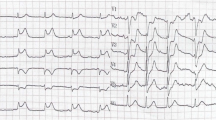Abstract
Background
Kounis syndrome (KS) has been described as an acute coronary syndrome (ACS) associated with an anaphylactic reaction. Several triggers have been identified and the diagnostic and treatment process can be challenging.
Case
A 58-year-old, female patient diagnosed with breast cancer and no history of allergies had subcutaneous injection of patent blue V dye for sentinel lymph node biopsy (SLNB). Intraoperatively, she developed anaphylactic shock and was transferred to the intensive care unit (ICU). A few hours later, electrocardiographic alterations and elevation of blood troponin were observed. Emergency coronary angiography revealed no occlusive lesions in coronary vessels. Further investigation in the allergy department set the diagnosis of KS.
Conclusion
There are just ten cases of perioperative KS in the literature so far and here we present the first one triggered by patent blue V dye for sentinel node biopsy.


Similar content being viewed by others
References
Bézu C, et al. Anaphylactic response to blue dye during sentinel lymph node biopsy. Surg Oncol. 2011;20(1):e55–e59.
Barthelmes L., et al. on behalf of the NEW START and ALMANACH study groups. Eur J Surg oncol. 2009.
Montgomery LL, et al. Isosulfan blue dye reactions during sentinel lymph node mapping for breast cancer. Anesth Analg. 2002;95(2):385–8.
Kounis N, Zavras G. Histamine-induced coronary artery spasm: the concept of allergic angina. Br J Clin Pract. 1991;45(2):121–8.
Kounis NG. Kounis syndrome: an update on epidemiology, pathogenesis, diagnosis and therapeutic management. Clin Chem Lab Med (CCLM). 2016;54(10):1545–59.
Kounis NG, et al. Kounis syndrome: a new twist on an old disease. Fut Cardiol. 2011;7(6):805–24.
Helbling A, et al. Incidence of anaphylaxis with circulatory symptoms: a study over a 3-year period comprising 940 000 inhabitants of the Swiss Canton Bern. Clin Exp Allergy. 2004;34(2):285–90.
Abdelghany M, et al. Kounis syndrome: a review article on epidemiology, diagnostic findings, management and complications of allergic acute coronary syndrome. Int J Cardiol. 2017;232:1–4.
Lopez PR, Peiris AN. Kounis syndrome. South Med J. 2010;103(11):1148–55.
Biteker M. A new classification of Kounis syndrome. Int J Cardiol. 2010;145(3):553.
Akyel A, et al. Late drug eluting stent thrombosis due to acemetacine: type III Kounis syndrome: kounis syndrome due to acemetacine. Int J Cardiol. 2012;155(3):461–2.
Kaartinen M, Penttilä A, Kovanen PT. Accumulation of activated mast cells in the shoulder region of human coronary atheroma, the predilection site of atheromatous rupture. Circulation. 1994;90(4):1669–788.
Gázquez V, et al. Kounis syndrome: report of 5 cases. J Investig Allergol Clin Immunol. 2010;20(2):162–5.
Wickman M. When allergies complicate allergies. Allergy. 2005;60:14–8.
Kounis NG. Kounis syndrome (allergic angina and allergic myocardial infarction): a natural paradigm? Int J Cardiol. 2006;110(1):7–14.
Mazarakis A, et al. Cefuroxime-induced coronary artery spasm manifesting as Kounis syndrome. Acta Cardiol. 2005;60(3):341–5.
Simons FER, et al. World allergy organization anaphylaxis guidelines: 2013 update of the evidence base. Int Arch Allergy Immunol. 2013;162(3):193–204.
Roffi M, et al. 2015 ESC Guidelines for the management of acute coronary syndromes in patients presenting without persistent ST-segment elevation: task force for the management of acute coronary syndromes in patients presenting without persistent ST-segment elevation of the european society of cardiology (ESC). Eur Heart J. 2016;37(3):267–315.
Simons FER, et al. World allergy organization anaphylaxis guidelines: summary. J Allergy Clin Immunol. 2011;127(3):587–593.e22.
Kristensen SD, Aboyans V. 2017 ESC Guidelines for the management of acute myocardial infarction in patients presenting with ST-segment elevation. Eur Heart J. 2018;39:119–77.
Barthelmes L, et al. Adverse reactions to patent blue V dye–The NEW START and ALMANAC experience. Eur J Surg Oncol (EJSO). 2010;36(4):399–403.
Paulinelli RR, et al. A prospective randomized trial comparing patent blue and methylene blue for the detection of the sentinel lymph node in breast cancer patients. Revista da Associação Médica Brasileira. 2017;63(2):118–23.
Guo W, et al. Evaluation of the benefit of using blue dye in addition to indocyanine green fluorescence for sentinel lymph node biopsy in patients with breast cancer. World J Surg Oncol. 2014;12(1):290.
Karakatsanis A, et al. The Nordic SentiMag trial: a comparison of super paramagnetic iron oxide (SPIO) nanoparticles versus Tc 99 and patent blue in the detection of sentinel node (SN) in patients with breast cancer and a meta-analysis of earlier studies. Breast Cancer Res Treat. 2016;157(2):281–94.
Peek MC, et al. Is blue dye still required during sentinel lymph node biopsy for breast cancer? Ecancermedicalscience. 2016;10:674. https://doi.org/10.3332/ecancer.2016.674.
Funding
None to disclose for all authors.
Author information
Authors and Affiliations
Corresponding author
Ethics declarations
Conflict of interest
The authors report no conflict of interest.
Informal consent
For this type of study formal consent is not required.
Additional information
Publisher's Note
Springer Nature remains neutral with regard to jurisdictional claims in published maps and institutional affiliations.
About this article
Cite this article
Frountzas, M., Karathanasis, P., Vrakopoulou, G.Z. et al. Kounis syndrome after patent blue dye injection for sentinel lymph node biopsy. Breast Cancer 27, 1191–1197 (2020). https://doi.org/10.1007/s12282-020-01129-5
Received:
Accepted:
Published:
Issue Date:
DOI: https://doi.org/10.1007/s12282-020-01129-5




